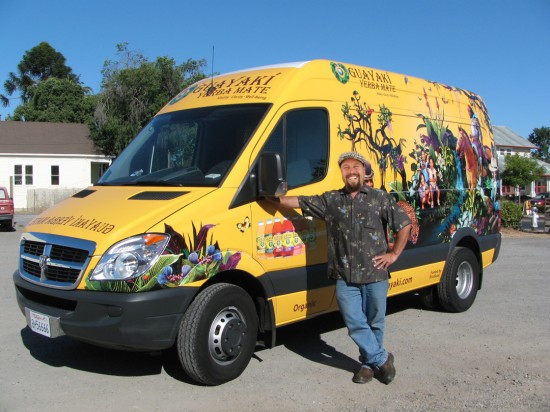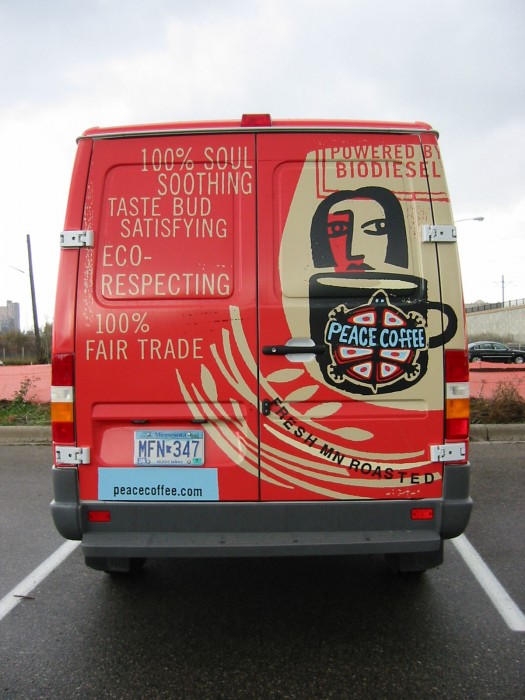Guayaki Yerba Mate runs an NCV3 Sprinter on B100, EcoShuttle too, and Essential Baking runs all their nine Sprinters on biodiesel. It’s better for the environment, for your engine, and may even be cheaper. Why not your Sprinter fleet too?
I’ve written about biodiesel Sprinters a few times before, both Sprinters fueled by vegetable oil (VO) and also those using commercial biodiesel, as well as for a chapter on biodiesel in my Sprinter RV Conversion Sourcebook. But I haven’t run my own 2008 NCV3 Sprinter on biodiesel yet. Why am I not running it on “bio” already, you ask? Well, for one thing, because Daimler Vans USA doesn’t exactly encourage you to use biodiesel. They support the use of B5 biodiesel in NAFTA Sprinter vans (presumably for its better lubricity as compared to standard ULSD diesel fuel, and higher cetane rating), but this is the de facto standard for much diesel fuel in the US now, for example in Oregon where many pumps carry stickers noting that any “dino” diesel may actually be B5 biodiesel. Engine damage deemed to have been caused by use of a higher biodiesel blend than B5 is not covered by the Mercedes warranty.
For another, similar to other alternative/renewable energy sectors that threaten fossil fuel monopolies in North America in some way, the young biodiesel production sector has been hampered by vacillating government support, particularly the on-again/off-again Biodiesel Production Tax Credit. Numerous commercial suppliers have not maintained consistent supplies of commercial biodiesel because of the uncertainty, forcing big layoffs in 2010. And this has also meant we haven’t seen local stations (depending on the state) carrying biodiesel products in quite the numbers you might hope for, were you thinking of running your Sprinters on biodiesel.
That said, I have talked to almost a dozen people who are running their Sprinters on WVO/SVO or commercial biodiesel (typically B20 or B100). Most have T1N Sprinters with the 2.7-liter engine, but among those who run commercial biodiesel (biodiesel which meets the ASTM D7651 standards), many run their Sprinters on B20 and B100 biodiesel with no problems. Their tips:
- Switch fuel lines: Before you run biodiesel blends above B20, you will have to change your Sprinter’s fuel lines – SAE J30R9 fluoroelastomer lined 3/8″ hose is necessary (such as the Viton hose available from GreaseWorks), because of the solvent properties of blends above B20.
- Change fuel filters early: If the vehicle has been run on straight petro-diesel up for more than 10,000 miles before then, then soon after switching to biodiesel, you may need to change fuel filters a few times until the diesel sludge from the tanks and lines is cleared away by the biodiesel. If the fuel filter is completely clogged, the engine may not start without a new fuel filter.
- Ensure you have high-quality fuel: Your fuel source MUST be clean, and meet the US ASTM D6751 standards (in the EU, there is the EN 14214 standard, and sub-variants for individual EU countries, like the BS EN 14214 standard for the UK). Owners who have problems running biodiesel in their Sprinters (problems can include blown injectors, and blown high-pressure fuel pumps) typically have used biodiesel fuel with water contamination (water vaporizing as steam pits injectors) or solid contaminants of some sort (contaminants and viscosity issues can destroy high-pressure lift pumps).
- Keep checking for contamination: The newest NCV3 Mercedes Sprinter common-rail diesel engines are not ideal for biodiesel, because of the way they’ve chosen to meet EPA emissions standards. Before you say “it’s that damn EGR and DPF, isn’t it?”, note that biodiesel actually might help DPF regeneration. No, it’s more that post-2007 diesels typically use an in-cylinder post-combustion squirt of fuel as part of their emissions system. This post-combustion squirt vaporizes but does not combust, and the biodiesel makes its way past the piston rings and migrates into the crankcase, where it dilutes engine oil and in some cases, polymerizes on the insides of the crankcase (polymerization can also happen with substandard biodiesel fuel in the fuel tank). Contamination of engine oil with biodiesel can cause high wear on the engine. Pre-2007 diesels do not have this post-combustion squirt, so there is less engine oil contamination. However, there is still some oil contamination with fuel even on engines without the post-combustion squirt, so oil sampling/monitoring (either periodic Blackstone sampling or a device like the IntelliStick that monitors engine oil) is a good idea. Good news for 2007-2012 NCV3 Sprinters, though: you can now get individually-customized Sprinter tunes/ECU re-flashes from CustomSpooling that disable post-combustion injection and DPF regeneration, which should help a lot with running biodiesel in a newer Sprinter.
- Change blends in cold weather: In cold weather, you will want to drop back to a lower blend, your supplier may be knowledgeable about what’s necessary for your region. For example, Essential Baking in Seattle reportedly runs their 2005 Sprinter vans on B100 much of the year, but then drops back to a B75 blend from December to March. B100 used in cold temperatures (depending on the type of feedstock used for its production, which influences its clouding point/gelling point) may increase difficulties starting and produce viscosity issues that, as mentioned above, can lead to pump problems.
And just to say it again: a consistent theme in stories about successful use of biodiesel by fleet owners (and also in this Maryland guide) is that fleet owners need to find a good supplier of commercial-grade biodiesel (which may take more than one try). Essential Baking tried another supplier, with poor results, before finding Propel Fuels, a biofuels supplier in Washington state and California. This U of Idaho paper details some biodiesel production methods, mostly super-technical, but pages 8-10 detail some problems that suppliers might have and potential questions you can ask about their testing and storage methods to evaluate any possible quality issues.
UPDATE: William Sampson from EcoShuttle comments on using B100 with their NCV3 Sprinter: “Our Sprinter is a 2007 model which we started using B100 with the day we rolled it off the dealer’s lot. We did not switch out any fuel lines for the use of biodiesel. We did have a local company install a fuel tank heater which did not work so well; there was either an install issue or the components were not working properly. We had this unit rendered useless and had to use B50 in the colder months. We did use B100 during the winter of 2007 and 2008 which caused the Sprinter to act sluggish until it was running for a small amount of time…One major issue we had by using B100 was the burning up of the EGR valve. We were lucky enough to have this replaced about 4 times free-of-charge because of the warranty. Once the warranty had expired, the valves cost us anywhere between $600-$900 a piece. Of coarse, we did have to replace the fuel filter every once in a while. After we had the Sprinter Center replace the first one, I was shown how to do it so the next few times I was able to purchase the part and replace it myself…The fuel source we use is from Sequential which is located in Eugene, OR. Their fuel does meet all ASTM standards and is used for the B5 mandatory diesel blend in Multnomah County, OR.”
ASKING YOUR FEEDBACK: Are you a fleet owner considering running your Sprinters on biodiesel? What’s motivating you, or stopping you?






Comments on this entry are closed.